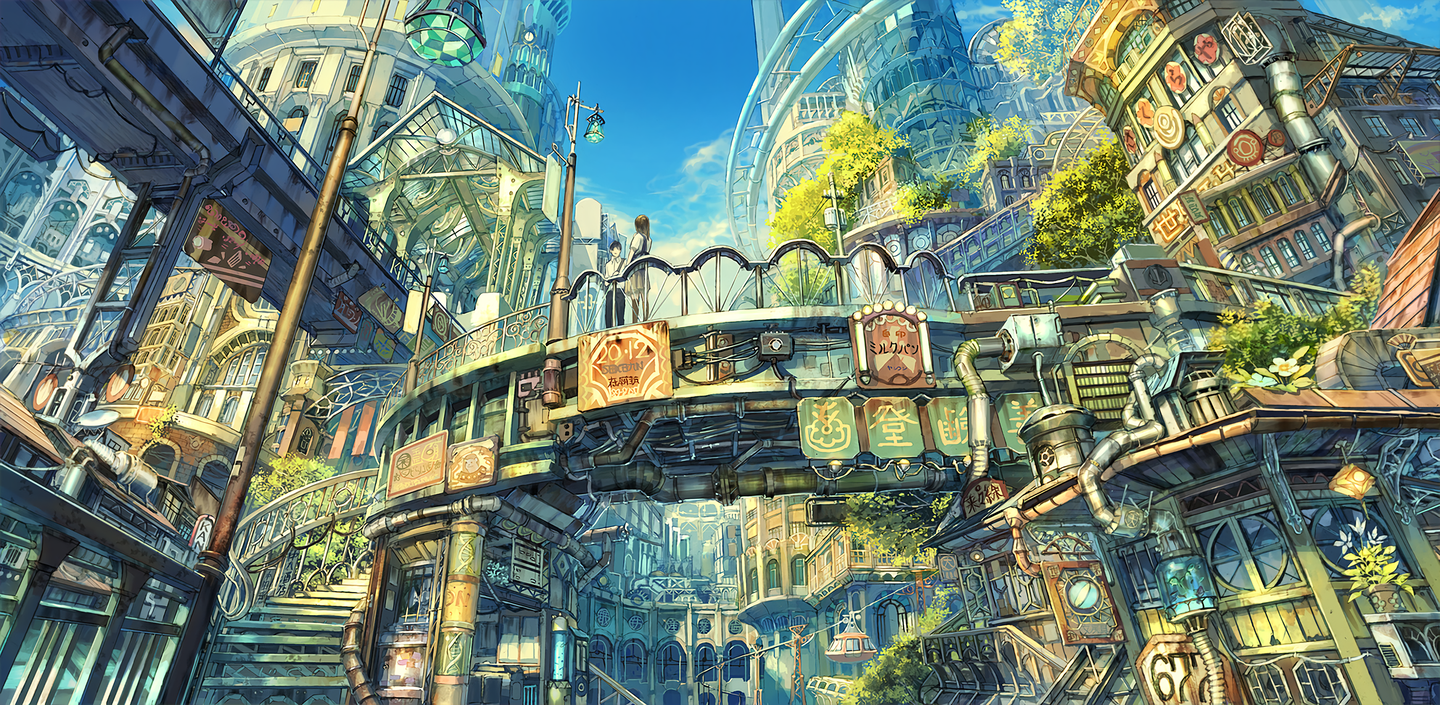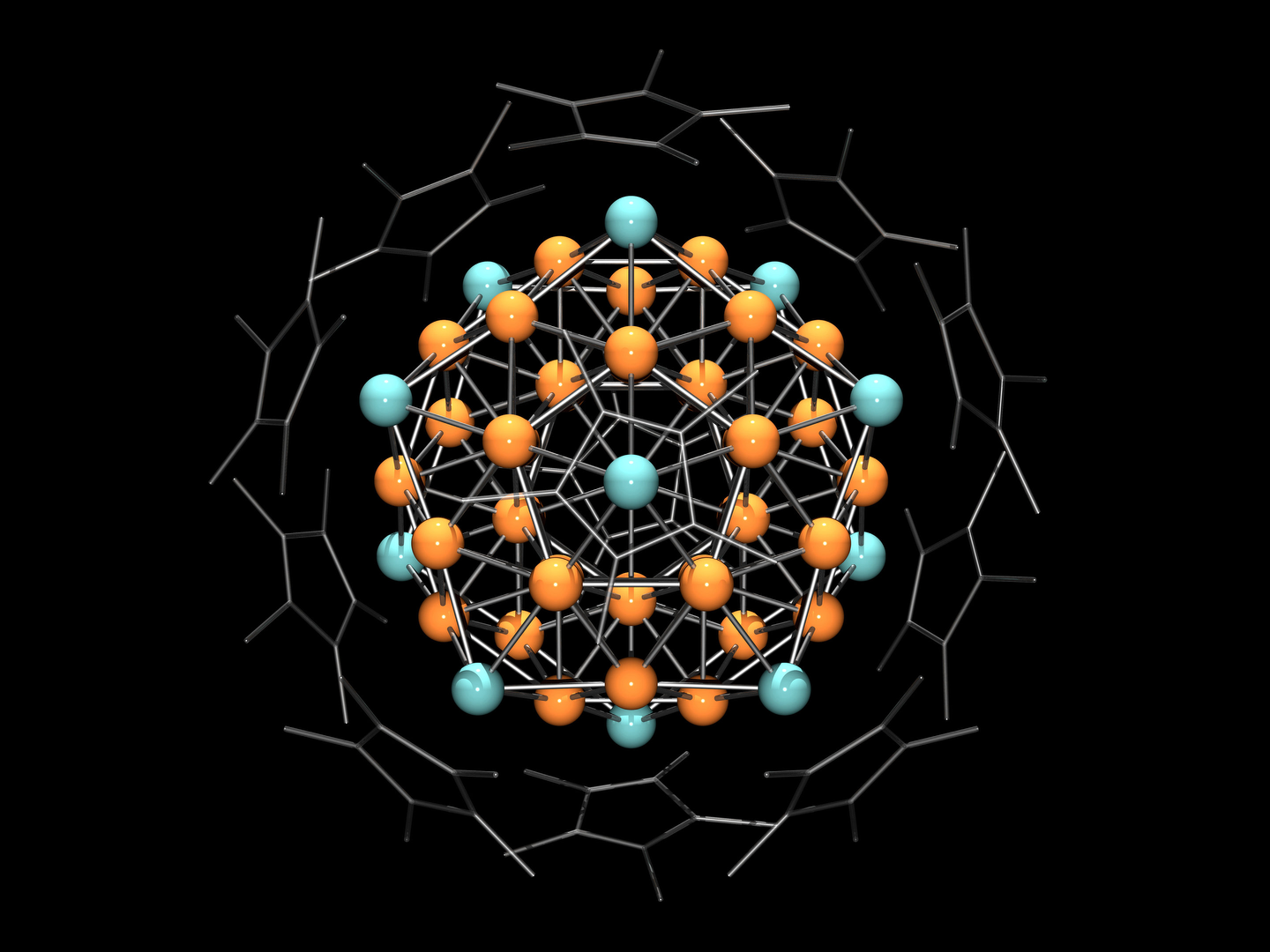Note: this essay is the updated and expanded version of a talk given in residency at Trust on June 29, 2019. It adds about 1500 words of connective material to the original talk transcript.
What does “fully automated” mean, and what can we learn about the desire for “full automation?”
These two words usually come attached to another pair: “luxury communism.” Originally proposed by Aaron Bastani, the phrase’s popularity was compounded by the release of Nick Srnicek and Alex Williams’ 2015 book Inventing the Future. Intentionally or not, “fully automated luxury communism” has become the calling card of left acceleration, the basic political stances of which I will now briefly rehearse.
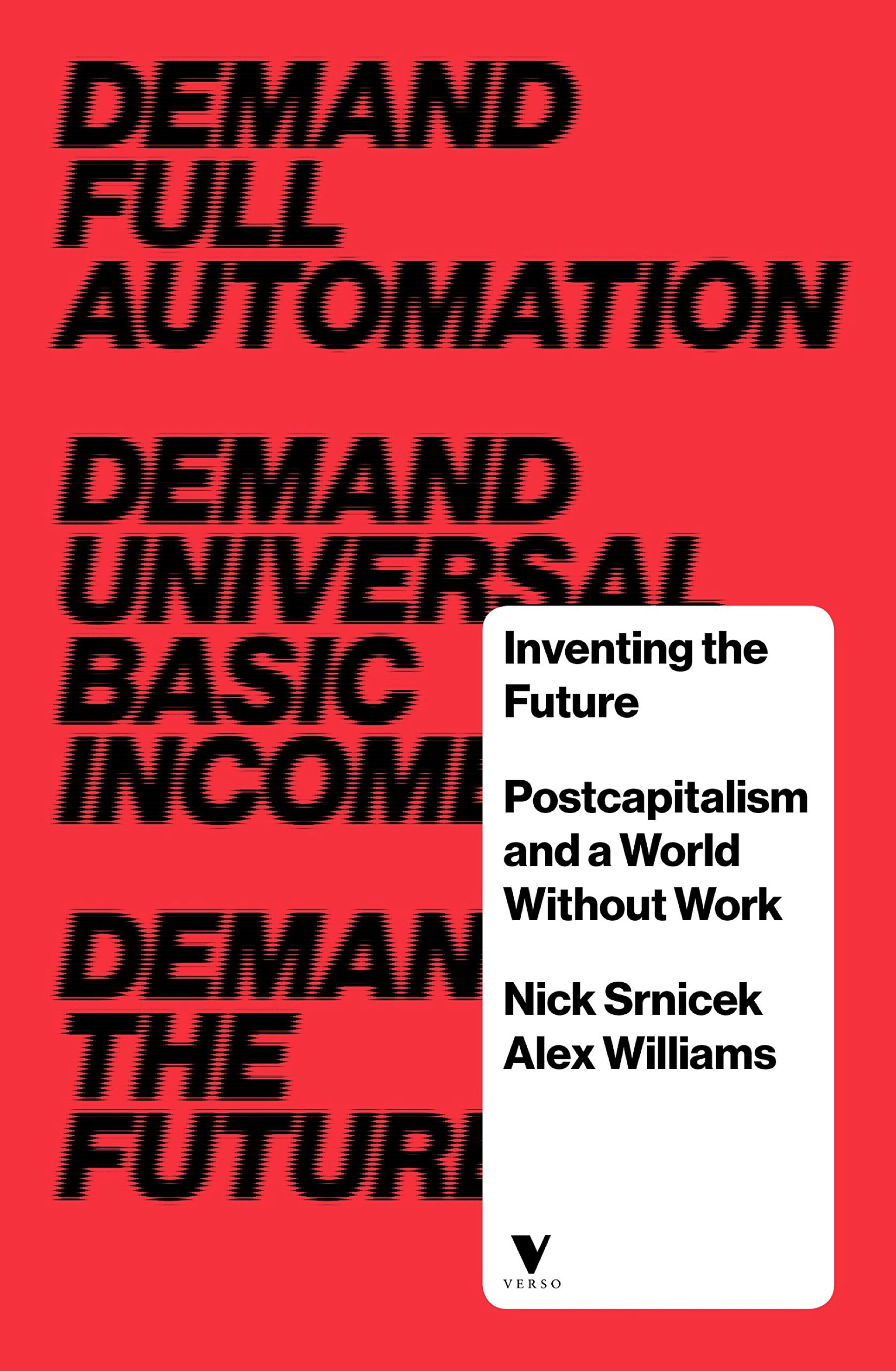
Left acceleration positions itself in opposition to a neoliberal present, with which all of us here are familiar in a theoretical and personal way. “What has occurred,” Srnicek and Williams say in their #Accelerate Manifesto, “is the progressive elimination of the work-life distinction, with work coming to permeate every aspect of the emerging social factory.” They argue that technology and science has been enslaved to capitalist objectives, and that this scenario must be reversed: capital must be subordinated to a technoscientific political project, such as that imagined in the famous Chilean governance initiative Cybersyn.
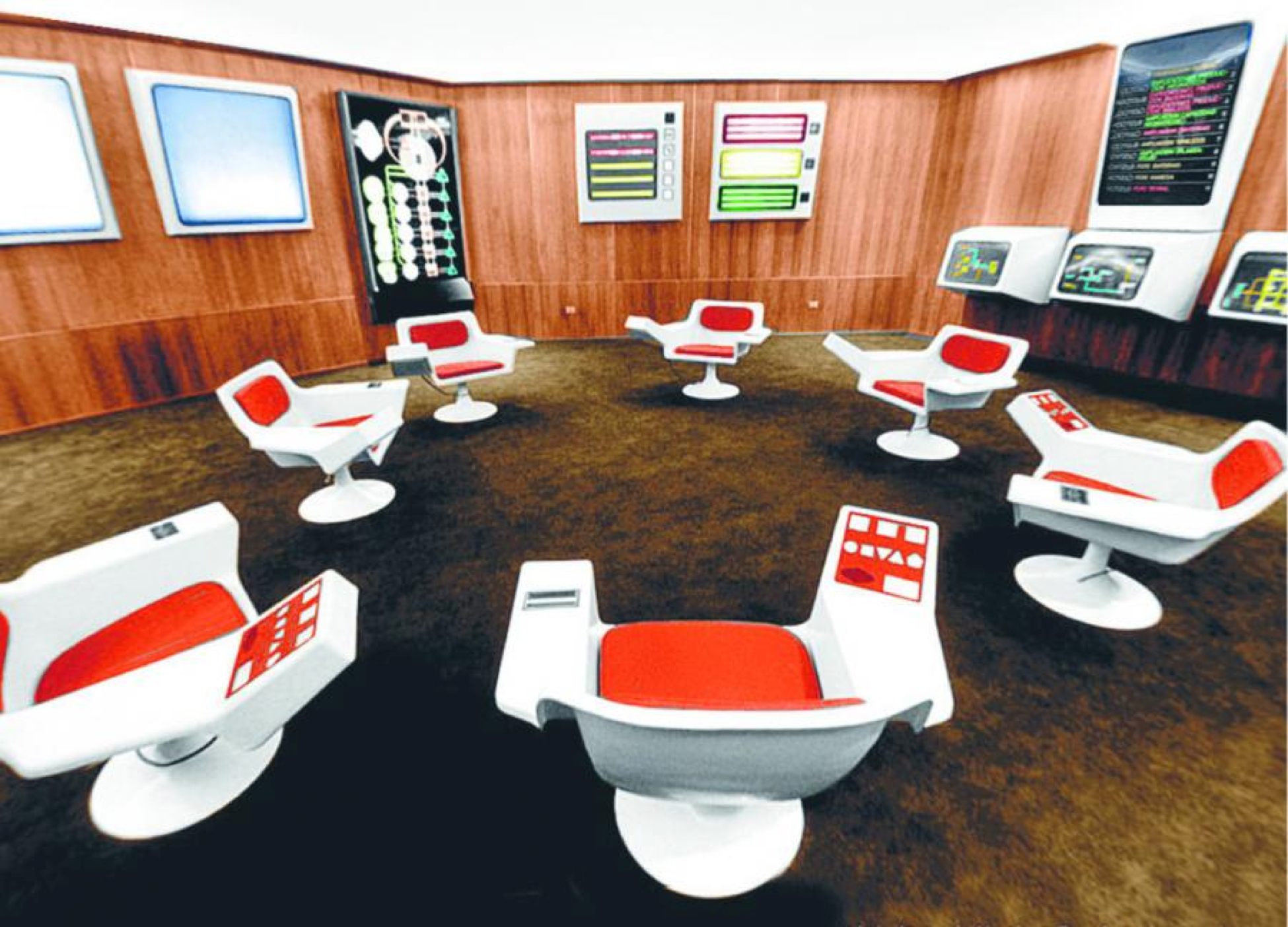
Such a technocapital system would be a national or a world computer, through which an economy can be managed and every need provided for. Near the end of Post-Capitalist Desire, another seminal left accelerationist text, Mark Fisher says (emphasis mine):
The reactionary elements within capitalism can only conceive of urban modernity, cyberspace, and the decline of the family as a fall from a mythical organic community. But can’t we conceive of consumer capitalism’s culture of ready meals, fast food outlets, anonymous hotels and disintegrating family life as a dim pre-echo of precisely the social field imagined by early Soviet planners such as LM Sabsovich? …. The Soviet system could not achieve this vision, but perhaps its realisation still lies ahead of us, provided we accept that what we are fighting for is not a “return” to the essentially reactionary conditions of face-to-face interaction, “a line of racially pure peasants digging the same patch of earth for eternity,” or what Marx and Engels called “the idiocy of rural life,” but rather the construction of an alternative modernity, in which technology, mass production and impersonal systems of management are deployed as part of a refurbished public sphere. Fisher, 2012
This is the left accelerationist vision of technology, mass production, and automated management deployed for the good and collective wealth of the public. Perhaps you have already begun to imagine what this looks like. Cross-continent hyperloops powered by solar energy! Advanced simulations calculating region-wide supply and demand and adjusting production accordingly! An automated sharing economy! Universal basic income! Leisure time! Green cities!
Yet this particular strain of political imagination has fallen under critique from both ends of the spectrum. Nick Land critiques left accelerationism from the right, on the basis that it represents a sort of self-deceit in which we convince ourselves there is an engine of acceleration and growth beyond capital itself. Can a self-reinforcing cybernetic system of technocapital really be made beholden to ideological ends? Land answers this question in the negative.
Others in the Italian anticapitalist tradition critique left accelerationism from the left, pointing out that the desire for “liberation” or “emancipation” intrinsic to these notions of “full autonomy” have always been a part of capitalist claims. Industrialization has always been represented as leading to a “technological destiny” that would free humans from their worldly limitations. Raniero Panzieri, for instance, proved that:
The introduction of newer machines, the stimulus to research, to new scientific discoveries and their application within an unending process of technological development—these are the essence of capitalist accumulation. Capitalist accumulation consists of an overwhelming wave of new technologies as a means of human domination of nature. That is precisely why it is the factor of innovation in the process of accumulation that produces surplus. Raniero Panzieri quoted in The Project of Autonomy, Pier Vittorio Aureli, 2008.
In both critiques, it is human capability, human liberation, human autonomy that is at stake when “full automation” is invoked. This is crucial to understand. It is a question of agency—what we are able to do under technocapital, and what we are able to do without it. It is this question I want to explore today.
The idea of left accelerationism is that with full automation, we will no longer be slaves to this system of technocapital, but masters of it or at least collaborators with it. We will, in essence, gain agency, whereas now we are merely agents of capital. Here are some further selections from Srnicek and Williams which capture this.
“We declare that only a Promethean politics of maximal mastery over society and its environment is capable of either dealing with global problems of achieving victory over capital.”
Or here: “towards a time of collective self-mastery, and the properly alien future that entails and enables. Towards a completion of the Enlightenment project of self-criticism and self-mastery, rather than its elimination” (Srnicek et al, 2013).
Here, the desire for “full autonomy” is a desire for “maximal mastery.” It is a desire for a pure human autonomy, unconstrained by capital. This is precisely what Nick Land gets at in his interview linked above: “what the left means by emancipation is freedom from capital autonomization.” But would this really be agentive? Or what kind of agency would it actually be?
![]()
I have adapted this chart from Vitalik Buterin’s 2014 taxonomy of organizations and their relationship to automation. Vitalik’s original chart features DAOs and dapps; I’ve kept same the axes but replaced the contents with systems of production, so it now maps humans’ relationship to technology and capital.
On the bottom right is a regime of fully manual production, which relies on humans for every element of labor and management. Feudalism could also be considered such a system. Conversely, the top left is a system in which humans have no involvement at all, a vision of HAL-9000, or Tsutomu Nihei’s City, an enormous Dyson sphere whose Builders incessantly expand it into outer space.
On the bottom left, humans are the engine of production, but aided by light automation. On an individual level, automation at the edges could be considered to be tools, but at scale it is closer to a Fordist system of assembly line production. Left accelerationists do not want a return to Fordism, “where workers received security and a basic standard of living in return to a lifetime of stultifying boredom and social repression” (Srnicek et al, 2013). Instead, the argument is to put automation at the center: to build a system that can deterministically create wealth and reduce work.
Yet such a system would only have an understanding of humans as a subject that consumes the goods and services it produces. It would render humans necessary only insofar as we produce demand. And in a sense, this is what capital already is. It’s certainly what evolution is: an automated system which relentlessly executes its logic without any understanding for whatever is subjected to it. And if you understand an economy to be an evolutionary system, as many modern economists do (Beinhocker, 2006), it will make sense that capital is already something that continues to accelerate, grow, and evolve without any regard for human well-being.
![]()
Capital is already a system that we have tried to use for our benefit, but whose center is an automaton that operates without any regard for humans, and whose telos is the runaway growth we now feel entrapped by. So we are already under a form of “full automation”—one which is essentially out of our hands.
As increasingly complex networks of technology are deployed, human versus automated agency is becoming an increasingly pressing question (with research relating algorithmic bias and income inequality just one instance of how this topic is making its way into mainstream discourse).
Fiser, Srnicek, Williams, Bastani, and others attempt an answer. But as we have just seen, left acceleration presents a paradox. It relies on notions of human capability, liberation, and control which are contravened or constrained by capital; yet we can see that this sense of anthropocentric control would also be threatened by any kind of fully automated technocapital system or command economy. This paradox arises from a specific historical construal of agency, one which Westerners are largely under the influence of today. This conceptualization of agency has, in my view, at least three principles.
-
Agency is something that humans possess. To express it, we must free ourselves from various limitations.
Agency is an intrinsic quality that can be expressed as long as we dispose of the things that hinder it. We see this understanding of agency not only in the accelerationist “liberation from work” discourse, but in traditional Western psychology, in which we describe our problems as “neuroses” which hold us back and are to be removed or resolved. Cognitive-behavioral therapy carries on this tradition by identifying “harmful” mental patterns and motivating their change. -
Mankind is the sole possessor of agency; nature is inert and we must reshape it to suit our needs.
This is visible in our typical inability to attribute agency to our environment and animals and plants in it. Westerners tend to view plants and trees as inanimate objects, and animals as automatons executing more or less sophisticated consumption and reproduction functions. -
Meaning exists in our minds, rather than in things. Meanings are, at some level, human physiological states.
This understanding of agency insists that the world is intrinsically meaningless, and that we do not have access to “things in themselves” but mere mental representations of things we create. It might be unclear how this is relevant for now, but I’ll explore it more shortly.
All of these conceptualizations are not just about agency, they are clearly important to what it means to be human. They define humankind and distinguish it from other beings. We are agentive, meaning-making entities. Agency, therefore, is construed as a good. It’s something we’re supposed to have, that we should possess, and not having it is considered quite bad. All three elements are captured well in this quote from philosopher Alain Renaut:
Fundamentally, humanism is the conception and valorization of humanity in its capacity for autonomy. What I mean . . . is that what constitutes modernity is the fact that man thinks of himself as the source of his representations and acts, as their foundation (subject) or their author. . . The man of humanism is the one who no longer receives his norms and laws either from the nature of things (Aristotle) nor from God, but who establishes them himself on the basis of his reason and will. Quoted in A Secular Age, Charles Taylor, 2007.
This is what I mean when I say “meanings are in the mind.” It is through our agency that meaning exists at all.
I have to tell you that for many years, I had a kind of fixation on agency, on a personal level. It may have originated in childhood, but the first time I remember thinking about it was in Japan, in Tokyo, on New Year’s Eve of 2012-2013, at Meiji Shrine, with hundreds of other people crowded around me.
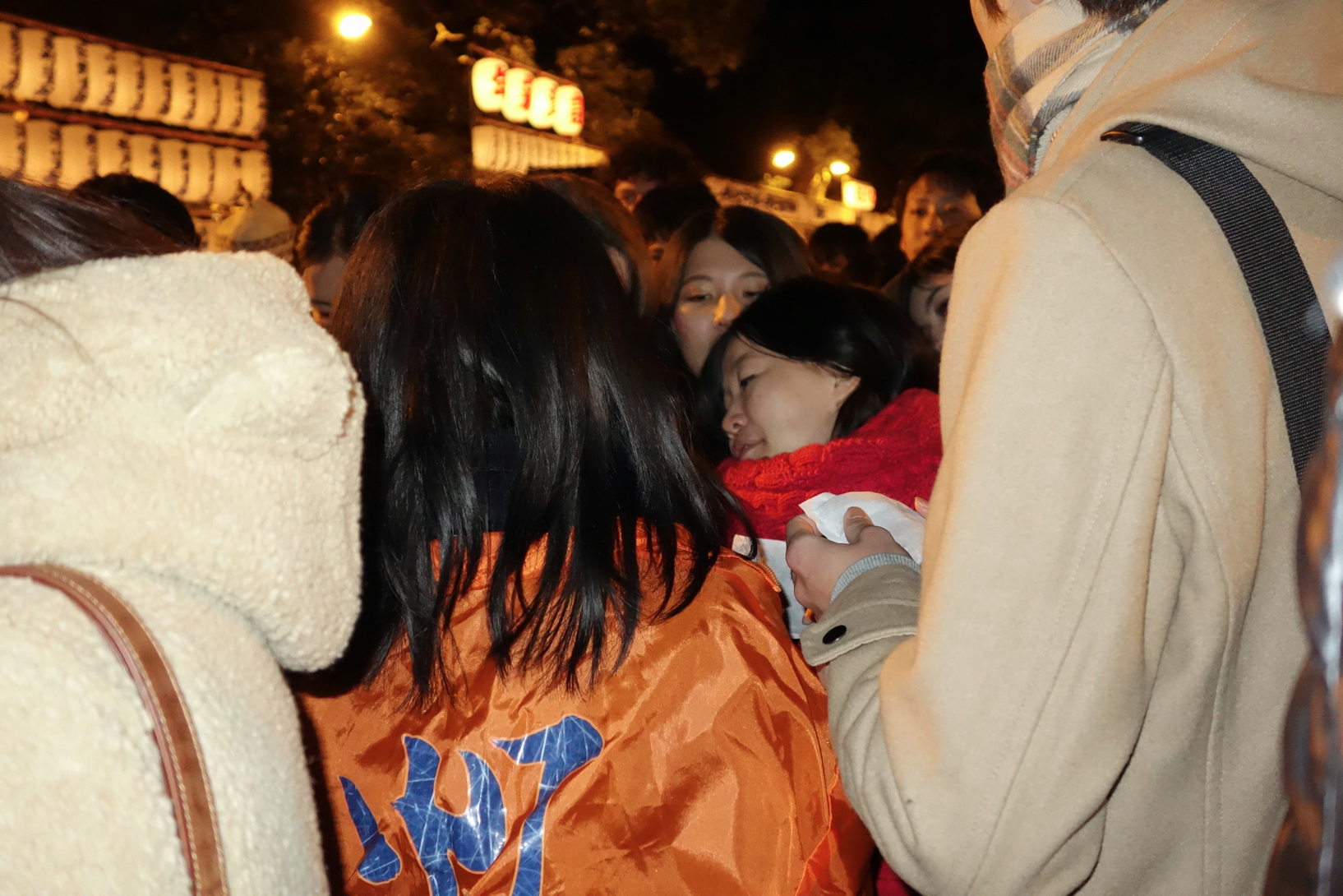
I had just gotten an internship over laboring over an email exchange in business Japanese and presenting my first proper portfolio, and I was exhilarated. As the new year was ringing in, I found myself thinking these words: “by my own will, by my own hand.” It even had a sort of tune to go with it, rising and crescendoing with every note, which in retrospect I can see acoustically represented the stressful position of responsibility I put myself in with this framing.
I understood agency in this way for a long time, and it informed my relationship to just about everything. When I failed to do something I wanted, like start a company, or move out of my apartment, or finish a project, it was because I exhibited insufficient willpower. With my psychologist, many things we discussed were channeled through a framing of “things I wanted to do” and both interior and exterior “obstacles to those things.” I was dismissive of and unempathetic toward people who I felt couldn’t take enough responsibility, or didn’t show enough willpower to change themselves—a sure sign I feared my own lack of agency. And I resented authority figures, and needed to feel “maximal mastery” in a work setting, leading to conflicts with bosses, and later the sweet release of precarious self-employment.
Perhaps some of this will sound familiar to some of you. This egocentric liberal individualism is underpinned by the same concept of agency we have just discussed, the one behind this desire for “full automation.” A pure human autonomy.
Recently, I’ve been reading Charles Taylor’s book A Secular Age. This book is, in a way, about how this concept of agency came to arise. Taylor calls it “exclusive humanism.” There were a long series of historical developments that led to the rise of exclusive humanism, which I won’t go into today. The point is that we have not always lived this way.
In Renaissance and medieval society, we lived with another agency, or rather an agent: a super-agent, called God. God permeated every part of society. God was part of the public sphere, part of celebrations, part of the family, of every form of social organization. We could not go anywhere without encountering God, because “the social bond at all these levels was intertwined in the sacred” (Taylor, 2007).
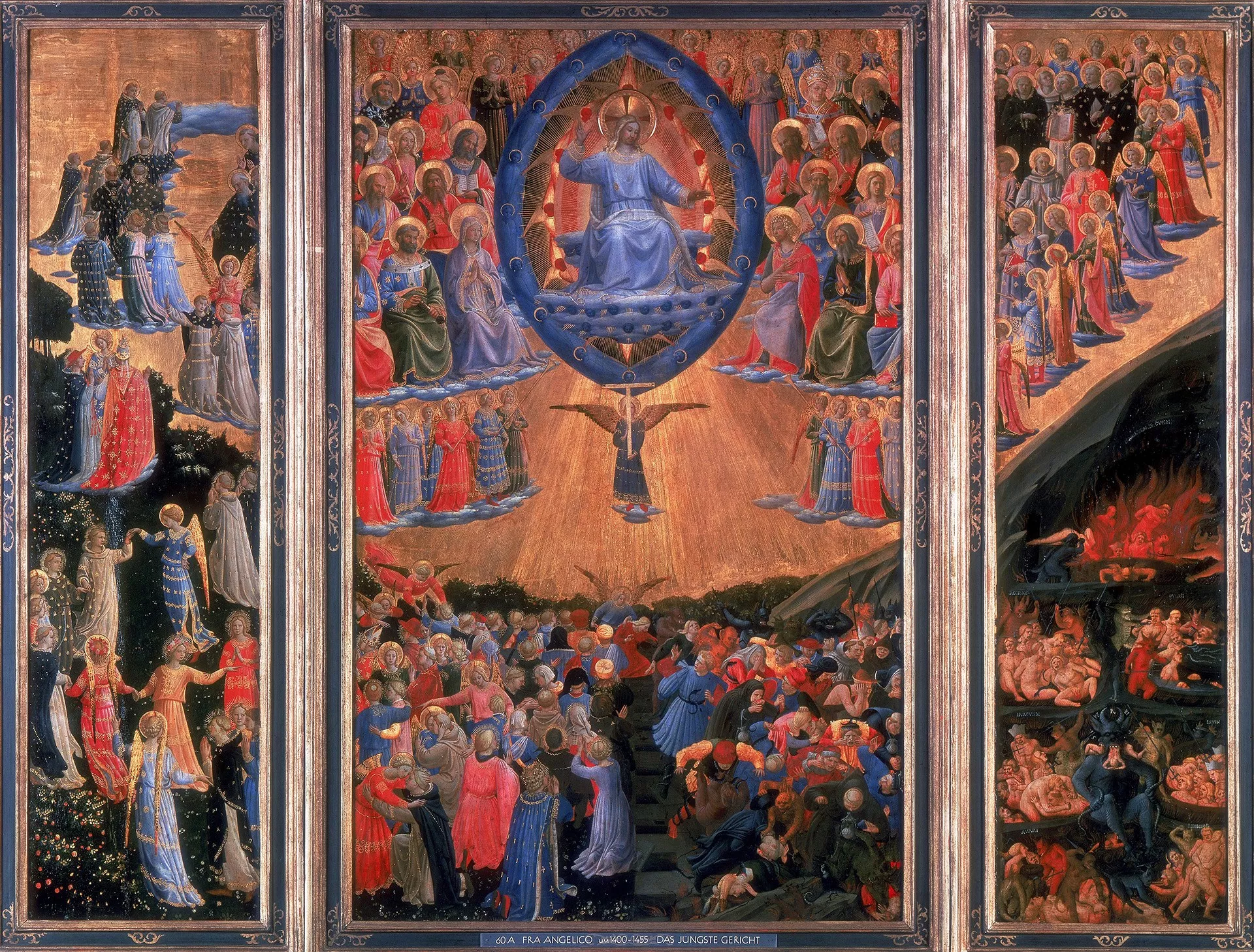
In this world, enchanted by God’s presence, meanings were not “in the mind.” They were in the world, in plants and animals, but also in demons, spirits, angels, and magical objects such as relics, like this textile relic of Saint Matthew.

The meaning and significance of these objects were not located in our mental representations—we did not have a concept of mental representations at all. We did not believe, as we do now, that we formed an internal “mental concept” or that we “believed in meanings” that gave symbols their power. Instead, objects and beings had their own meaning, and they imposed that meaning on us! Can you imagine what it’s like to understand the world in this way? Even if we try, it’s very difficult.
In this enchanted world, objects and spirits had real causal power, their own form of agency. And go back even further than medieval Europe, to traditional human tribes, and we find an even more “animated” world, where there’s not just one God figure but many gods and a natural spirit in everything. As religious historian Mircea Eliade writes, for traditional humans the world the cosmos “is a divine creation, coming from the hands of the gods, the world is impregnated with sacredness… the cosmos is a living organism, which renews itself periodically.”
Moreover, we naïvely believed in God—naïvely as in we were simply not aware of an option not to. Today, we tend to view such naïve belief as “hegemonic,” or as a form of suppression. You might identify that as the deconstructive tendency of the postmodern project, but with some perspective, we see it’s also an extension of the modern, exclusive humanist, liberalist view of agency that I am trying to throw into contrast. If agency is foundational to being human, surely not having options of belief is a form of suppressing our humanity. Eliade captures this nicely:
Modern nonreligious man assumes a new existential situation; he regards himself solely as the subject and agent of history, and he refuses all appeal to transcendence. In other words, he accepts no model for humanity outside the human condition as it can be seen in the various historical situations. Man makes himself, and he only makes himself completely in proportion as he desacralizes himself and the world. The sacred is the prime obstacle to his freedom. He will become himself only when he is totally demysticized.
In both the medieval and traditional forms of society, mankind was at the whim of God and nature. We could die in any number of ways. A locust wave (sent by God) ruined our crops, or you ate a poisonous berry, were bitten by a snake, or attacked by a bear, or some other cruel fate. To mitigate these eventualities the best we could do was pray to God, or for traditional humans, participate through ritual in the regeneration and renewal of the cosmos, an effort to help reinstantiate the natural order. So humans, weak and marginal, were just one figure in a cosmos of acting, agential beings and spirits.
Is this too not a form of full autonomy? Could we not say that human beings lived in a fully automated world then? One in which we were not at the center, but at the edges, just one part?
The phrase “full autonomy” is rooted in the Marxist traditions we explored earlier, Marxist traditions which also owe themselves to the exclusive humanist version of causality. But what if our desire for full autonomy is not a desire for “maximal mastery and total liberation, but the desire for limited agency? The desire to live once again in a naïve state of belief, one in which we are not paralyzed by optionality? The desire for a time when humans felt their power was very little in comparison to the rest of the world, which was self-evidently preordained and ordered and populated by the living gods?
Here’s that chart once more. It’s the same axes, but instead of automated technological systems, in this new version, the nonhuman agency is the divine.
![]()
Once again, in the bottom right, we have a fully “manual” system of belief with no other agent besides humans in it, the exclusive humanism we have been talking about. On the top right where FALC was, we now cede maximum agency to the order of the sacred. the animating spirit, the God or gods, with us at the edges.
This view of full automation helps explain the current cultural obsession with the medieval and the popular revival of magic. Interest in feudalism, cults, guilds, witches, astrology, chaos magic, are not just a passing Tumblr trend but still on the rise. There’s this persistent meme, the origin of which I don’t know, that people turn to magic in times of uncertainty. The assumption therein is that magic will help people gain control over the world. But this “control” is, in most cases, an abdication of control, a subordination of human control to a higher cosmic logic.
But isn’t it bad to return to this era of magical thinking? Wouldn’t we be deceiving ourselves about what is possible if we start talking to trees? We will at least be depriving ourselves of agency, right?
From our exclusive humanist perspective, the answer would be yes. But with recent developments in the humanities and in physics, some cracks in this modern understanding of agency are starting to show.
Designers in the crowd may already be familiar with James Gibson’s ecological approach to visual perception. Gibson coined the term “affordances” to describe how the shape of things affords to us what we can do with it. A bottle that fits in my hand affords its pick-up-ability; a door handle affords its ability to be pulled. Gibson: “an affordance… is equally a fact of the environment and a fact of behavior. It is both physical and psychical, yet neither. An affordance points both ways, to the environment and to the observer.”
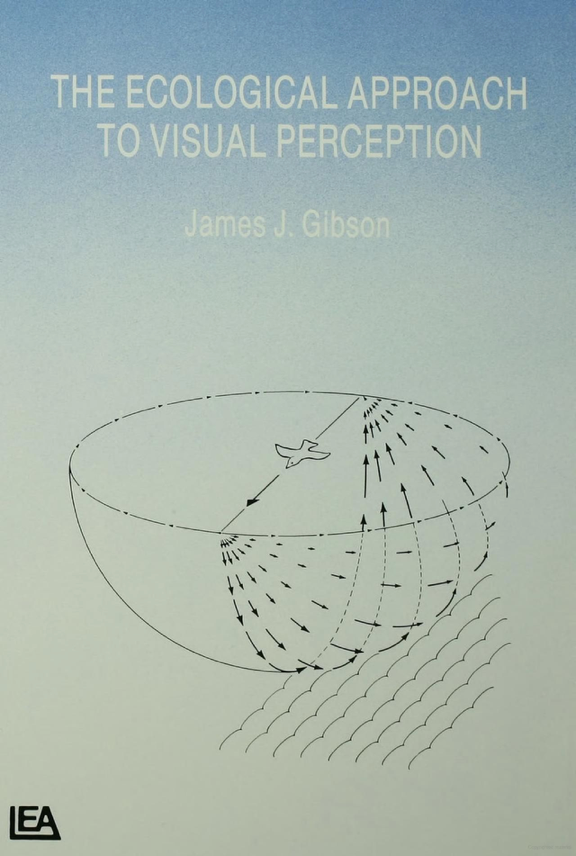
Gibson’s theory of affordances suggests that our meanings are not just in our minds, but created in relation to other entities, inanimate and animate. A two-humped camel affords being sat on.
The relatively new field of biosemiotics applies a similar idea to all nature, going a step further. The flower’s scent is an affordance of being edible to the bee. Or again with plants, the leaves of rubber plants have a central groove and grow in a way that channels water flow to the plant’s base: rain and water is literally represented in the shape of the leaves. Or even with our total environment: the light of our sun affords the existence of eyes.

We can call these phenomena “affordances” or “non-human representation” or “indexicality” or “signaling” or whatever we like. Regardless of naming, they go beyond our everyday anthropocentric view of representation and symbols, and capture a relational dynamic of active communication between beings, between humans and humans, humans and nonhumans, and nonhumans and nonhumans. This communication happens both in an immediate interaction, and on a grand evolutionary scale.
From our exclusive humanist view, it’s easy to accuse theories like this of “incorrectly” anthropomorphizing plants and animals (see again the categorical distinction made between between humans and nonhumans). But even from a rigorously materialist approach, exclusive humanism is being shown to be unviable.
Theoretical physicist and feminist theorist Karen Barad has developed a view of agency by working from contemporary quantum physics. Her argument takes as its foundation the famous “double slit” thought experiment.


We know light exhibits wave-like behavior, because when we shoot photons through two slits, we get a diffraction pattern, similar to if we had pushed a wave of water through the slits. However, if we modified the device to detect which slits of light individual photons go through, the diffraction pattern would disappear, and light behave as if it were merely particles.
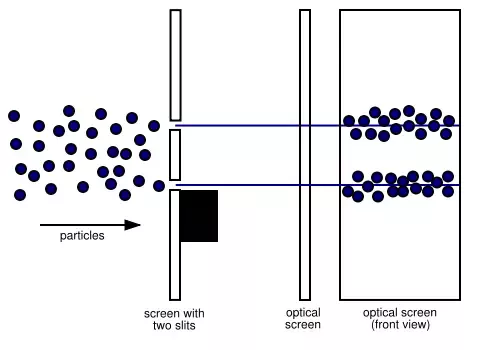
These two behaviors are contradictory within classical physics, which assumes that light has an objective nature which we can observe. But in this case, the behavior of light interacts with the entire apparatus, including the observing element! Barad, following Niels Bohr, concludes that the results of this experiment mean that even at the fundamental level of physics, there are no independently existing objects with inherent characteristics. Things exist purely in relation to one another. To get quite technical, Barad goes on to define what she calls an “agential cut,” which is what happens when something within a phenomenon (like the photon observer in the above experiment) enacts a local causal structure, defining behavior in that local system and excluding certain eventualities from occurring.
It seems to me that exclusive humanism, as a discourse, an epistemology, and an ontology of agency, is a local causal structure we find ourselves in now. And as obvious as it seems to us, these accounts are shaking the foundations of that structure. What is emerging is a different understanding of the world.
- Agency is not a posessable quality, but relational. Actions are always interactions and intra-actions.
- All things are agentive as they behave, exist, and afford in relation with other beings.
- Meanings objectively exist in the relation between material things, including but not limited to human minds.
When I visualize agency from this perspective, it no longer seems like something I or anyone “has.” Instead, it appears to me as a 3-dimensional field of networked nodes. Connections between two nodes show an afforded relation between them. To quantify agency in this field would be impossible. At best, you could define agency as the possibility space that is sensible (literally, what can be sensed) by any given node. Disconnected nodes mean there are no affordances in the local system in that can be sensed. Even before systems of thought comes into play, the 5 human sensing apparatus enact a different understanding of causality than those of a bat. Or a better example: we understand certain things to be possible and impossible because we believe we have only 5 senses. Our senses and affordances produce the possible.
In this new view of agency, is there not the possibility for a different understanding of objects and beings? Can we not hear “what things tell us” as a legitimate category of experience? From this perspective, it is impossible to look at objects as totally dead and lifeless, animals and plants as deterministic little machines executing their programs. In this view, not only do they have their own way of making meaning, but they once again can impose their meanings on us. And on a personal level, people like me no longer have to hold ourselves as the sole locus of responsibility, because our agency and constraints are always a factor of our environment, events, and things in it.
Affordances and Karen Barad’s experiments take us away from the “atomic” world view that underpins classic Newtonian physics, which sees the world as made up of aggregates of discrete atomic entities, bumping around in the void. At the same time, they upset the atomistic view of humans! We tend to view humans as individual actors, relationships as something which exists between these individuals, and the social contract as an abstract agreement between individuals.
Anthropologists who study tribal humans have created the concept of the dividual: the person who is a composite of relationships. The Nayaka tribe in southern India, for example, have social interactions and relations with trees, hills, rocks, and elephants. This is not because they a priori consider them to be persons. It’s because see those entities as having relationships with them. “They see these particular elephants were devaru [gods, super-persons] as they ‘walked harmlessly’ and ‘looked straight into the eyes,’ that is, as and when they responsively related to Nayaka.”
Nurit Bird-David, an anthropologist of the Nayaka people, calls animism a relational epistemology. “If the object of modernist epistemology is a totalizing scheme of separated essences, approached ideally from a separated viewpoint, the object of this animistic knowledge is understanding relatedness from a related point of view within the shifting horizons of the related viewer” (Bird-David, 1999).
The relational view of agency affects every level of our belief systems.
Selfhood: agency not in our individuality or our autonomy, but through our dividuality, our existence as made up of relations.
Causality: one thing does not act unidirectionally and isolatedly on another, but folding in all aspects of the situation, including the observer.
Psychology: agency not as liberation from our neuroses, but from working with them, from preferencelessly holding and learning from negative feelings.
Responsibility: agency not as increasing total responsibility and autonomy, but the ability to share and remake responsibility with others. Sometimes, what we want can not be accomplished through exacting control, only through release and vulnerability.
While relational agency is crucial to understand, as a species we obviously cannot just return to animism, because we no longer have the naïvety of our historical youth. We do not exist in an optionless world. Our job in the coming centuries is to reconcile this view with our scientism and humanism. I can only conclude that it is the Western spirituality movement, the new age complex with yoga, pseudo-Buddhism, and veganism as its hallmarks, that represents the most likely path for this relational view to achieve mass adoption. If you are immediately repulsed and disappointed by this idea, it’s probably a good idea to examine your own relationship to vulnerability, agency, and meaning.
We Westernized humans live with an illusion of control. We live in a world of unconstrained intelligence, agency, and animate capability, which we refuse to perceive as meaningfully alive. Yet we are obsessed with the creation of an artificial entity with “general intelligence” that mimics the form of agency we mistakenly believe we have. That we keep moving the goalposts for what can be considered “real AI” is an indictment of our epistemology: we are blind to causal power where it is.
“Unconditional” or right-leaning accelerationists fetishize capital’s autonomy and liken it to an intelligence of its own. Where they are right is that they acknowledge the existence of nonhuman entities with their own agency, affordances, and goals. Why not view capital as a leviathan? As a Lovecraftian old god? Frankly, that might make our condition more livable.
In animistic cultures, what happened when things went wrong? When they too faced a crisis, confronted with the hostility of their environment? In these situations, our ancestors’ solution was to ritually recreate the foundation of the cosmos, the separation of earth from water. They began time again. In this way traditional man was always close to a sacred time beyond the profane everyday.
Hence the essential importance, in rituals and myths, of anything which can signify the “beginning,” the original, the primordial (new vessels and “water drawn before sunrise” in popular magic and medicine, the motifs of the the child, and so forth). This idea that life cannot be restored but only re-created through repetition of the cosmogony is very clearly shown in curative rituals. In fact, among many primitive peoples, an essential element of any cure is the recitation of the cosmogonic myth; this is documented, for example, among the most archaic tribes of India, the Bhils, the Santals, the Baigas. It is through the actualization of the cosmic Creation, exemplary model of all life, that it is hoped to restore the physical health and spiritual integrity of the patient. Among these tribes the cosmogonic myth is also recited on the occasion of birth, marriage, and death; for it is always through a symbolic return to the atemporal instant of primordial plenitude that it is hoped to assure the perfect realization of each of these situations. Eliade, 1959
Our current definition of agency, and our understanding of ourselves, constitute a finite game, a game played over many thousands of years, but nevertheless with a definite conclusion. Its telos is to be history’s final agent; the only being left when it is all over. The consequences of this game are both a deprecation of the past and a foreclosure of the future. It locks us into a present that refuses to pass, metal and plastic stacking up until our history abruptly and painfully ends.
Seeing our agency as one inseparable from our surroundings, our relatives, our collaborators in life can change our impetus from accumulation to equilibrium. Accelerating instead toward entropy, we must now play an infinite game, one in which we too are constantly regenerating time.

